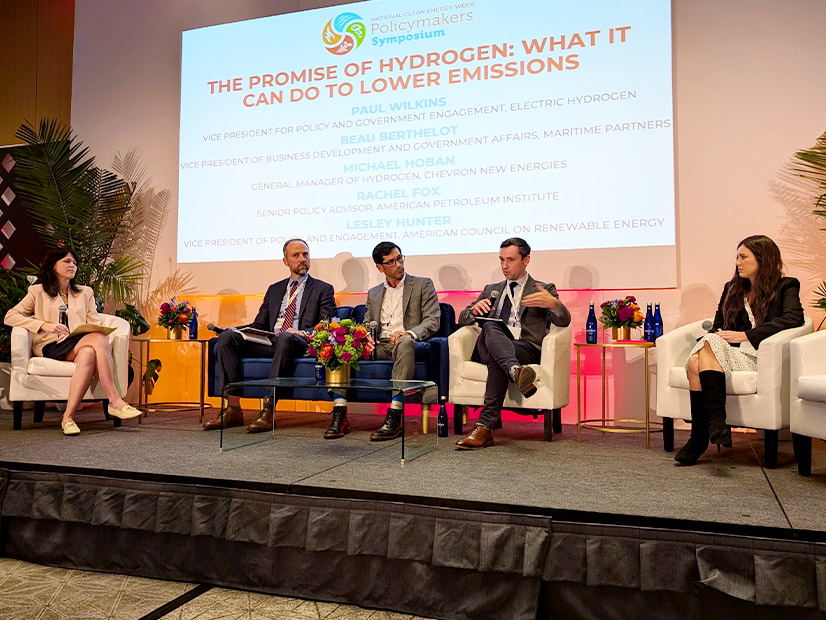
WASHINGTON — A panel on hydrogen at the National Clean Energy Week Policymakers Symposium provided a state-of-the-industry update, looking at cutting-edge projects underway and the reluctance of developers and investors to move ahead as they wait for the Treasury Department’s final rule on the Inflation Reduction Act’s 45V tax credit.
The world’s smallest molecule is widely being promoted as a potentially clean alternative fuel that can be used in hard-to-abate sectors, such as long-haul trucking or maritime shipping, or for long-duration storage. Hydrogen traditionally has been produced using natural gas as a feedstock, called blue hydrogen. But green hydrogen is produced by electrolysis ― splitting water molecules into oxygen and hydrogen ― powered by renewable energy.
Chevron has a long history of producing blue hydrogen but has become bullish on green as a sector where the company “can leverage our assets and capabilities and relationships to really drive forward the energy transition,” said Michael Hoban, vice president for policy and government engagement at Chevon New Energies. “Our focus is lowering the carbon intensity of our own operations, as well as creating low-carbon businesses … where we think Chevron can add value.”
Speaking at the Sept. 26 panel, Hoban pointed to Chevron’s Advanced Clean Energy Storage (ACES) project in Utah, which will produce green hydrogen from “about 220 MW of electrolyzers, storing about 100 tons per day of hydrogen [in] massive underground salt caverns … as a long-term energy [storage] solution.”
Beau Berthelot, vice president of business development and government affairs at Maritime Partners, a maritime leasing and financing firm, said his company is building a hydrogen-fueled vessel, which will extract hydrogen from methanol, also called methyl alcohol.
The new ship “will load methanol, convert the methanol into hydrogen, then fuel the vessel with hydrogen fuel cells,” Berthelot said.
But Treasury’s delay on the 45V production tax credit ― which could be worth up to $3 per kilogram of green hydrogen ― has frozen the market, said Paul Wilkins, vice president for policy and government engagement at Electric Hydrogen, which manufactures electrolyzers used to produce green hydrogen.
Treasury issued a proposed rule for 45V in December but has yet to issue a final rule. The department announced Oct. 1 that it intends to complete the final rule by the end of the year. (See Biden Admin. Issues Proposed Rules for Hydrogen Tax Credits.)
“Project developers can’t get to a final investment decision if they don’t know what their revenue streams look like,” Wilkins said. “And so what that means is that projects are just churning water and burning through cash … not moving forward.”
The U.S. has only about 150 MW of operating electrolyzers, a capacity he described as “tiny.” To bring down costs, “we really need to start scaling the industry.”
The Department of Energy’s seven regional hydrogen hubs, funded with $7 billion from the Infrastructure Investment and Jobs Act, also have had a slow rollout. The law requires the hubs to be geographically and technologically diverse, producing hydrogen from natural gas with carbon capture as well as electrolysis powered by renewables.
But one year after the seven hubs were announced, only three have finalized contracts with DOE.
Chevron is involved in two of the hubs, one on the Gulf Coast (still in contract negotiations) and one in California (contract finalized), Hoban said. With or without clarity on 45V, coordinating all the facets and stakeholders is difficult, he said.
“Hydrogen is a really difficult market to initialize for a lot of reasons,” he said. “Everything really has to happen at once. You can’t just simply make a supply project, and when it goes to the liquid market, you can’t simply buy a hydrogen fuel-cell truck. … The entire value chain needs to be coordinated together.”
Permitting reform also will be critical, Wilkins said, to ensure dedicated pipelines for hydrogen can be built. “That’s going to be the cheapest way to move those molecules,” he said.
Wilkins expects some projects, like the hubs, will co-locate the production of green hydrogen with its end uses. But “if you look at the places where you just make green hydrogen because you’ve got really cheap electricity, you’re going to have to move it,” he said. “We have to be able to build pipelines.”


